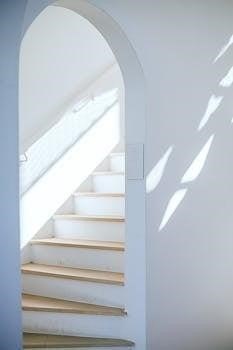Stair Guide⁚ Comprehensive Article Plan

This comprehensive article provides a detailed plan for understanding staircase design․ It covers regulations, dimensions, and safety aspects, providing a thorough understanding of building codes․ From rise and run ratios to handrail specifications, it offers a guide for planning your staircase project․

Stair design is a multifaceted discipline, intertwining aesthetics with stringent safety regulations․ This guide delves into the core principles of crafting staircases that are not only visually appealing but also compliant with building codes․ Understanding the regulatory landscape is paramount, as it dictates essential parameters like dimensions, headroom, and handrail specifications․
The design process requires a careful balance between meeting functional needs and adhering to legal requirements․ Considerations extend beyond mere measurements, encompassing material selection, spatial constraints, and the intended use of the staircase․ Whether for residential or public settings, a well-designed staircase ensures safe and comfortable passage between levels․ This introduction sets the stage for exploring the intricacies of staircase design and the critical role of regulations in ensuring occupant safety and structural integrity․ The design philosophy must adhere to limit state design principles, ensuring all structural aspects meet required standards․
Building Regulations Part K⁚ An Overview
Building Regulations Part K, titled “Protection from falling, collision and impact,” is pivotal for staircase design within the UK․ It outlines the essential safety measures to prevent accidents on stairways in both public and private buildings․ This regulation addresses various aspects, including the dimensions of steps, the required headroom, and the specifications for handrails․ Compliance with Part K is mandatory to ensure the safety of building occupants․

Part K sets forth clear guidelines on the rise and going of steps, as well as the overall pitch of the staircase․ It also specifies the minimum and maximum dimensions allowed for these elements․ Furthermore, the regulation covers the design of landings, ensuring adequate space and safety at the top and bottom of staircases․ Understanding and adhering to Part K is crucial for architects, builders, and homeowners alike to create safe and compliant stairways․ This overview serves as a starting point for a deeper dive into the specifics of Part K and its practical implications for staircase construction․
Key Staircase Dimensions⁚ Rise, Run, and Pitch
Understanding the key dimensions of a staircase – rise, run, and pitch – is fundamental to designing a safe and comfortable stairway․ The rise refers to the vertical height of each step, while the run denotes the horizontal depth of each step․ The pitch is the angle of the staircase, determined by the ratio of rise to run․ These dimensions are crucial for ensuring ease of use and compliance with building regulations․
Building codes typically specify minimum and maximum values for both rise and run․ The ideal ratio between these dimensions ensures a comfortable and natural walking experience․ A steeper pitch, resulting from a higher rise and shorter run, can make the staircase more challenging to navigate․ Conversely, a shallower pitch, with a lower rise and longer run, requires more horizontal space․ Careful consideration of these dimensions is essential for creating a staircase that is both functional and aesthetically pleasing․ Finding the right balance is key to a successful staircase design․
Understanding the 18-inch Rule for Staircases
The “18-inch rule” for staircases is a guideline used to ensure comfortable and safe stair design․ This rule suggests that the sum of the rise and run of a step should ideally equal 18 inches․ This empirical rule helps in determining a comfortable ratio between the vertical height (rise) and horizontal depth (run) of each step, promoting a more natural and less strenuous ascent or descent․
While not a strict regulation, the 18-inch rule serves as a practical benchmark for staircase design․ Deviations from this rule can result in steps that feel awkward or require excessive effort to use․ For instance, steps with a rise and run sum significantly less than 18 inches may feel shallow and require extra steps․ Conversely, steps exceeding 18 inches may feel steep and cause strain․ Adhering to the 18-inch rule contributes to a user-friendly staircase design․
Minimum and Maximum Dimensions for Rise and Going
Building regulations stipulate specific minimum and maximum dimensions for the rise and going of stairs to ensure user safety and comfort․ The rise, which is the vertical height of a step, typically has a maximum limit to prevent excessive steepness․ Conversely, it has a minimum to avoid shallow steps that can be tripping hazards․ The going, representing the horizontal depth of a step, also adheres to minimum and maximum limits for comfortable foot placement․
Generally, the individual rise should be between 150mm and 220mm, while the individual going should range from 220mm to 300mm․ These dimensions ensure that the stairs are neither too steep nor too shallow, maintaining a comfortable and consistent rhythm for users․ Adhering to these regulations is essential for compliance with building codes and for creating stairs that are safe and easy to navigate․
These limits are intended to accommodate a wide range of users and minimize the risk of falls or injuries․ Deviations from these specified dimensions can lead to non-compliance and potential safety hazards․
Stair Width Requirements⁚ Residential vs․ Escape Routes
Stair width requirements vary significantly depending on whether the staircase is in a residential setting or serves as an escape route in a building․ Residential stairs generally have a minimum width requirement to allow comfortable passage for occupants․ However, stairs designated as escape routes, especially in multi-story buildings, demand stricter width regulations to facilitate rapid and safe evacuation during emergencies․
Typically, the minimum stair width for residential properties is around 44 inches, though this may be less if the occupant load is below 50․ Escape routes, on the other hand, often require a minimum width of 1200 mm, or approximately 47․2 inches, and a clear width of 1000 mm (39․4 inches) between handrails to accommodate multiple people moving simultaneously․ These wider dimensions ensure that individuals can evacuate quickly without being obstructed․
Building codes emphasize the importance of adequate stair width for escape routes to prevent bottlenecks and ensure efficient evacuation․ The specific requirements can vary depending on local regulations and the building’s occupancy․
Head Height Regulations for Landings and Stairs
Head height regulations for landings and stairs are crucial for ensuring safe passage and preventing head injuries․ Building codes specify minimum head height requirements to provide adequate clearance for individuals using the staircase․ These regulations apply to both the stair treads and the landings to maintain consistent headroom throughout the staircase․
Generally, the minimum head height required is at least 2 meters (approximately 6 feet 7 inches) measured from the tread or landing to the ceiling or any overhead obstruction above․ This clearance ensures that most people can comfortably ascend or descend the stairs without having to duck or bend over, reducing the risk of accidents․
Maintaining the specified head height is essential not only for safety but also for compliance with building regulations․ Proper attention to head height during the design and construction phases helps create a staircase that is both functional and safe for all users․ Variations may occur based on local building codes, so consulting the relevant regulations is always recommended․
Handrail Specifications and Requirements
Handrail specifications are vital to ensuring staircase safety and accessibility․ Building codes mandate specific handrail designs to provide support and guidance for users․ These regulations address the height, grip, and continuity of handrails, as well as their structural integrity․ Handrails must be installed on at least one side of a staircase, and often on both sides depending on the width and occupancy․
The typical height requirement for handrails is between 34 and 38 inches, measured vertically from the stair tread nosing․ This height range accommodates a wide range of users, providing a comfortable and secure grip․ The handrail’s grip size is also specified, typically ranging from 1 1/4 to 2 inches in diameter, or having a similar ergonomic profile to facilitate easy grasping․
Continuity is another key aspect; handrails should run continuously along the staircase without interruptions from posts or other obstructions․ The ends of handrails must also be designed to prevent snagging or catching clothing․ Adhering to these specifications ensures that handrails provide reliable support and enhance staircase safety․
Space Saver Staircase Regulations
Space saver staircases, also known as alternating tread stairs, offer a compact solution for areas with limited space․ However, these staircases are subject to specific regulations to ensure safety and usability․ Building codes often address the unique design aspects of space saver stairs, focusing on tread dimensions, rise, and overall pitch․
The key characteristic of space saver stairs is their alternating treads, which require users to lead with alternating feet․ This design allows for a steeper pitch than conventional stairs, reducing the overall footprint․ However, the tread depth on each side must be sufficient to provide adequate support․ Regulations typically specify minimum tread depths and the overlap required between alternating treads․
Due to their steeper pitch and alternating tread design, space saver staircases may not be suitable for all users, especially those with mobility issues․ Building codes often restrict their use to specific applications, such as accessing lofts or secondary areas with limited occupancy․ Ensuring compliance with these regulations is crucial for the safety and accessibility of space saver staircases․
Materials and Design Considerations for Staircases

Choosing the right materials and design for a staircase involves balancing aesthetics, functionality, and structural integrity; Common materials include wood, steel, concrete, and glass, each offering unique properties and visual appeal․ Wood provides warmth and traditional charm, while steel offers modern sleekness and durability․ Concrete is robust and versatile, suitable for both indoor and outdoor applications, while glass adds a touch of elegance and allows natural light to flow․
Design considerations extend beyond material selection to encompass the overall style, layout, and safety features of the staircase․ Open staircases with minimal risers create a sense of spaciousness, while enclosed staircases offer privacy and sound insulation․ The placement of handrails and balustrades is crucial for safety, ensuring a secure grip and preventing falls․ Consider the staircase’s location within the building and its impact on traffic flow and accessibility․
Furthermore, compliance with building codes and regulations is paramount․ Ensure that the chosen materials meet fire safety standards and that the staircase’s design adheres to dimensional requirements for rise, run, and headroom․ By carefully considering these factors, you can create a staircase that is not only visually appealing but also safe, functional, and compliant with all applicable regulations․